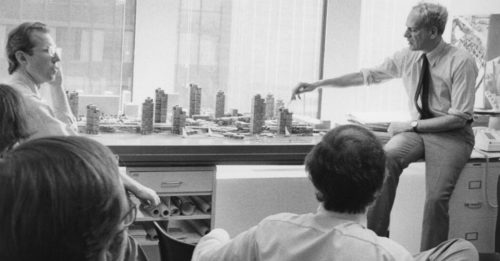
Paul Willen, Architect of Manhattan’s Waterfront, Dies at 93
February 21, 2022
By Penelope Green
Paul Willen, an architect and civic advocate who helped turn Trump City, a plan for a massive development on Manhattan’s West Side, into a tamer, gentler and more livable neighborhood called Riverside South, died on Feb. 2 in Berlin, Vt. He was 93.
The cause was heart failure, his son, Paul S. Willen, said.
For decades, a 57-acre slice of Manhattan waterfront, a former rail yard that stretched from 59th to 72nd Streets, had tempted and confounded developers. Donald J. Trump had various schemes for it in the mid-1970s, after which an Argentine company took it on. When that project failed to get financing, Mr. Trump stepped back in, with a bolder, brasher proposal.
He envisioned a giant shopping mall, topped by what at the time would have been the world’s tallest building, along with a clutch of skyscrapers and television studios (headquarters for NBC), all of which he called Television City. In 1988, after NBC pulled out, he renamed it Trump City.
Community groups and urban advocates were horrified by the plan. They mobilized and asked Daniel Gutman, an urban planner, to conduct an environmental review. In a search of city documents, he discovered Mr. Trump’s earlier plan for the site, from the 1970s, which had been produced by Gruzen Samton, Mr. Trump’s architects at the time, and designed by Mr. Willen, who worked in the planning department there.
Mr. Willen had proposed taking the crumbling elevated West Side Highway that sliced through the site and moving it inland, creating parkland surrounding tall buildings on the waterfront. Mr. Gutman knew Mr. Willen, and together they reworked his earlier design into a new proposal to counter Mr. Trump’s.
It was an elegant solution: Low-density buildings of varying heights would line a new boulevard covering the relocated highway, allowing for expanded parkland along the waterfront. The community groups and civic organizations, including the Municipal Art Society and the Parks Council, loved it, and they began to circulate what they called the Civic Alternative.
“It is a plan that at once celebrates the urbanism of New York and pushes it forward,” Paul Goldberger, the architecture critic of The New York Times, wrote in 1990. He called it both visionary and practical.
New Yorkers for Parks mourns the loss of Paul Willen, longtime Parks Council board member and champion for New York City, its parks, and the public realm. His insights and smile will be missed.